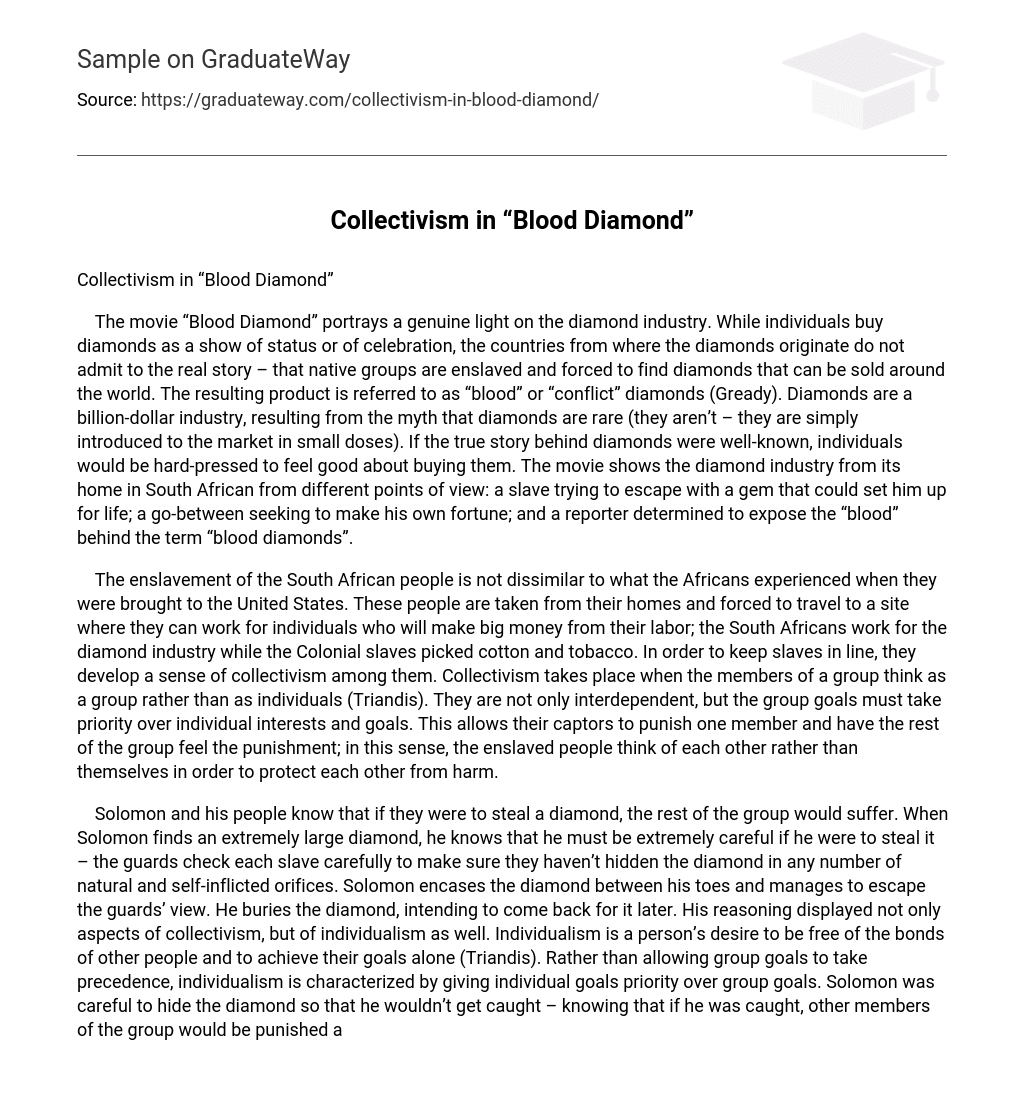The movie “Blood Diamond” portrays a genuine light on the diamond industry. While individuals buy diamonds as a show of status or of celebration, the countries from where the diamonds originate do not admit to the real story – that native groups are enslaved and forced to find diamonds that can be sold around the world. The resulting product is referred to as “blood” or “conflict” diamonds (Gready). Diamonds are a billion-dollar industry, resulting from the myth that diamonds are rare (they aren’t – they are simply introduced to the market in small doses). If the true story behind diamonds were well-known, individuals would be hard-pressed to feel good about buying them. The movie shows the diamond industry from its home in South African from different points of view: a slave trying to escape with a gem that could set him up for life; a go-between seeking to make his own fortune; and a reporter determined to expose the “blood” behind the term “blood diamonds”.
The enslavement of the South African people is not dissimilar to what the Africans experienced when they were brought to the United States. These people are taken from their homes and forced to travel to a site where they can work for individuals who will make big money from their labor; the South Africans work for the diamond industry while the Colonial slaves picked cotton and tobacco. In order to keep slaves in line, they develop a sense of collectivism among them. Collectivism takes place when the members of a group think as a group rather than as individuals (Triandis). They are not only interdependent, but the group goals must take priority over individual interests and goals. This allows their captors to punish one member and have the rest of the group feel the punishment; in this sense, the enslaved people think of each other rather than themselves in order to protect each other from harm.
Solomon and his people know that if they were to steal a diamond, the rest of the group would suffer. When Solomon finds an extremely large diamond, he knows that he must be extremely careful if he were to steal it – the guards check each slave carefully to make sure they haven’t hidden the diamond in any number of natural and self-inflicted orifices. Solomon encases the diamond between his toes and manages to escape the guards’ view. He buries the diamond, intending to come back for it later. His reasoning displayed not only aspects of collectivism, but of individualism as well. Individualism is a person’s desire to be free of the bonds of other people and to achieve their goals alone (Triandis). Rather than allowing group goals to take precedence, individualism is characterized by giving individual goals priority over group goals. Solomon was careful to hide the diamond so that he wouldn’t get caught – knowing that if he was caught, other members of the group would be punished as well. It was too big a risk for him to take. In addition, he had seen other slaves tortured as punishment for stealing a diamond, so he knew the consequences. It wouldn’t have occurred to him that he might get away with it or that he wouldn’t be punished – he thought of the entire group during this escapade. The individualism came into play when he took the diamond in the first place. Solomon separated himself from the group by taking the diamond and going off by himself (having given the excuse of relieving himself) in order to hide it. Not only was he taking a big chance, but he was risking the safety of the group as well.
According to Triandis:
In collectivist cultures, horizontal includes it sense of social cohesion and of oneness with members of the ingroup. Vertical includes a sense of serving the ingroup and sacrificing for the benefit of the ingroup and doing one’s duty.
The tribe in “Blood Diamond” was an example of horizontal collectivism. The members of the group had a sense of oneness with the rest of the group; when one suffered, the rest suffered as well. In Colonial times, slaves were often used to set an example for the misbehaving members of the group. The slaves know that they are equal with one another, that no single member of the group has a higher status or is more important than the other slaves. This comes from being a member of a slave class. However, slave mentality also shows some indication of vertical collectivism as well. Members of the group will often sacrifice for one another by covering for each other’s mistakes and especially for any thefts. Slaves have good reason to do so, as they are taught by their captors that individualism is unacceptable.
According to Edward Wilmot Blyden, a “slave mentality” exists which means that regardless of the physical boundaries one experiences, individuals who are enslaved will be so in their minds as well (Rashid). This is why the slave drivers in both South Africa and Colonial America did not need chains in order to keep the slaves; the slave mentality requires them to think as a group and to accept their circumstances. Collectivism is the mindset that forces slaves to think as a group; individualism allows them to think for themselves and occasionally break free from the bonds in which they find themselves. In conclusion, the sense of collectivism is another way to stating that people from similar background, culture and values tend to think as a group and to support each other based on their similarities.
Works Cited:
Rashid, Kamau. “Slavery of the Mind: Carter G. Woodson and Jacob H. Carruthers-Intergenerational Discourse on African Education and Social Change.” The Western Journal of Black Studies 29.1 (2005): 542+.
Smillie, Ian. “8 Climb Every Mountain.” Fighting for Human Rights. Ed. Paul Gready. New York: Routledge, 2004. 174-191.
Triandis, Harry C. Individualism ; Collectivism. Boulder, CO: Westview Press, 1995.





